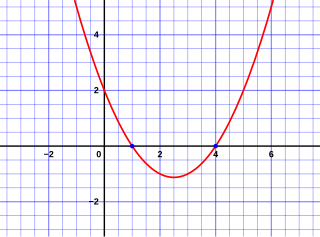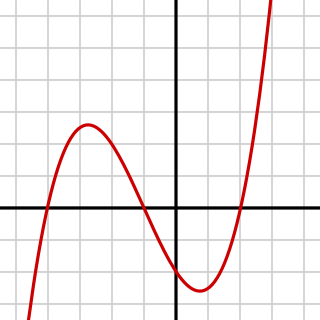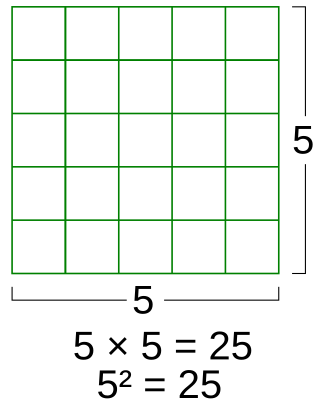Square Roots is a music festival in the United States.
Square Roots may also refer to:
- Square Roots: The Story of SpongeBob SquarePants , an animated film
- Square Roots (company), a vertical farming company cofounded by Kimbal Musk
Square Roots is a music festival in the United States.
Square Roots may also refer to:
Conjugation or conjugate may refer to:

A number is a mathematical object used to count, measure, and label. The most basic examples are the natural numbers 1, 2, 3, 4, and so forth. Numbers can be represented in language with number words. More universally, individual numbers can be represented by symbols, called numerals; for example, "5" is a numeral that represents the number five. As only a relatively small number of symbols can be memorized, basic numerals are commonly organized in a numeral system, which is an organized way to represent any number. The most common numeral system is the Hindu–Arabic numeral system, which allows for the representation of any non-negative integer using a combination of ten fundamental numeric symbols, called digits. In addition to their use in counting and measuring, numerals are often used for labels, for ordering, and for codes. In common usage, a numeral is not clearly distinguished from the number that it represents.
In numerical analysis, Newton's method, also known as the Newton–Raphson method, named after Isaac Newton and Joseph Raphson, is a root-finding algorithm which produces successively better approximations to the roots of a real-valued function. The most basic version starts with a real-valued function f, its derivative f′, and an initial guess x0 for a root of f. If f satisfies certain assumptions and the initial guess is close, then
In algebra, a quadratic equation is any equation that can be rearranged in standard form as
Radical may refer to:

In mathematics, a square root of a number x is a number y such that ; in other words, a number y whose square is x. For example, 4 and −4 are square roots of 16 because .

In elementary algebra, the quadratic formula is a formula that provides the two solutions, or roots, to a quadratic equation. There are other ways of solving a quadratic equation instead of using the quadratic formula, such as completing the square.

In mathematics, a root of unity, occasionally called a de Moivre number, is any complex number that yields 1 when raised to some positive integer power n. Roots of unity are used in many branches of mathematics, and are especially important in number theory, the theory of group characters, and the discrete Fourier transform.

In algebra, a cubic equation in one variable is an equation of the form
In mathematics, taking the nth root is an operation involving two numbers, the radicand and the index or degree. Taking the nth root is written as , where x is the radicand and n is the index. This is pronounced as "the nth root of x". The definition then of an nth root of a number x is a number r which, when raised to the power of the positive integer n, yields x:

In mathematics, a cube root of a number x is a number y such that y3 = x. All nonzero real numbers have exactly one real cube root and a pair of complex conjugate cube roots, and all nonzero complex numbers have three distinct complex cube roots. For example, the real cube root of 8, denoted , is 2, because 23 = 8, while the other cube roots of 8 are and . The three cube roots of −27i are

In algebra, a quartic function is a function of the form
Galileo's paradox is a demonstration of one of the surprising properties of infinite sets. In his final scientific work, Two New Sciences, Galileo Galilei made apparently contradictory statements about the positive integers. First, a square is an integer which is the square of an integer. Some numbers are squares, while others are not; therefore, all the numbers, including both squares and non-squares, must be more numerous than just the squares. And yet, for every number there is exactly one square; hence, there cannot be more of one than of the other. This is an early use, though not the first, of the idea of one-to-one correspondence in the context of infinite sets.

In mathematics, a square is the result of multiplying a number by itself. The verb "to square" is used to denote this operation. Squaring is the same as raising to the power 2, and is denoted by a superscript 2; for instance, the square of 3 may be written as 32, which is the number 9. In some cases when superscripts are not available, as for instance in programming languages or plain text files, the notations x^2 (caret) or x**2 may be used in place of x2. The adjective which corresponds to squaring is quadratic.

Lepidium meyenii, known as maca or Peruvian ginseng, is an edible herbaceous biennial plant of the family Brassicaceae that is native to South America in the high Andes mountains of Peru and Bolivia. It was rediscovered for commercial purposes at the Meseta de Bombón plateau close to Lake Junin in the late 1980s. It is grown for its fleshy hypocotyl that is fused with a taproot, which is typically dried, but may also be freshly cooked as a root vegetable. As a cash crop, it is primarily exported as a powder that may be raw, or processed further as a gelatinized starch or as an extract. If dried, it may be processed into a flour for baking or as a dietary supplement.
Methods of computing square roots are algorithms for approximating the non-negative square root of a positive real number . Since all square roots of natural numbers, other than of perfect squares, are irrational, square roots can usually only be computed to some finite precision: these methods typically construct a series of increasingly accurate approximations.
In mathematics, the square root of a matrix extends the notion of square root from numbers to matrices. A matrix B is said to be a square root of A if the matrix product BB is equal to A.
A root is the part of a plant, generally underground, that anchors the plant body, and absorbs and stores water and nutrients.
In mathematics, the radical symbol, radical sign, root symbol, radix, or surd is a symbol for the square root or higher-order root of a number. The square root of a number x is written as

Edmodo was an educational technology platform for K-12 schools and teachers. Edmodo enabled teachers to share content, distribute quizzes and assignments, and manage communication with students, colleagues, and parents. It was shut down on September 22, 2022.